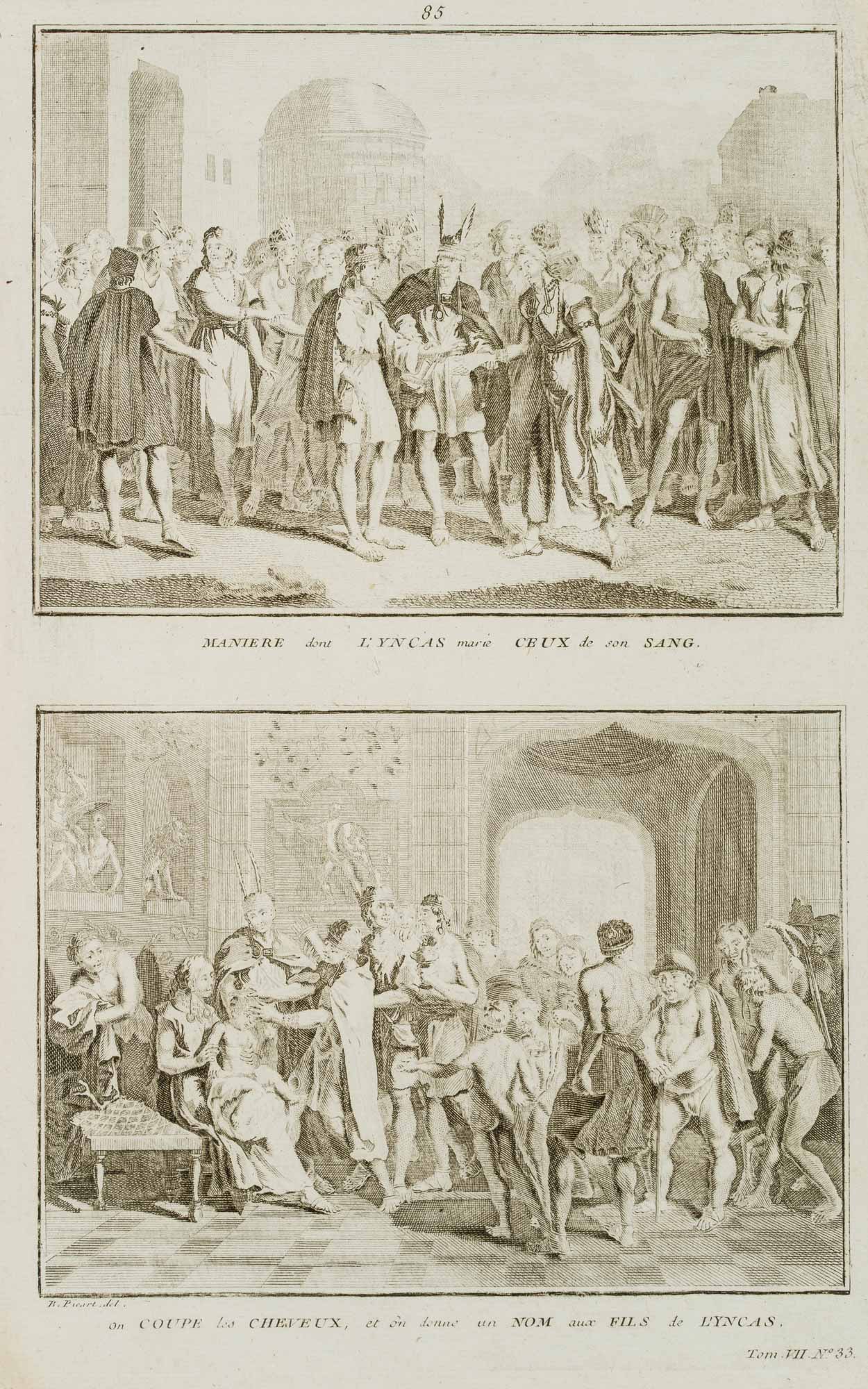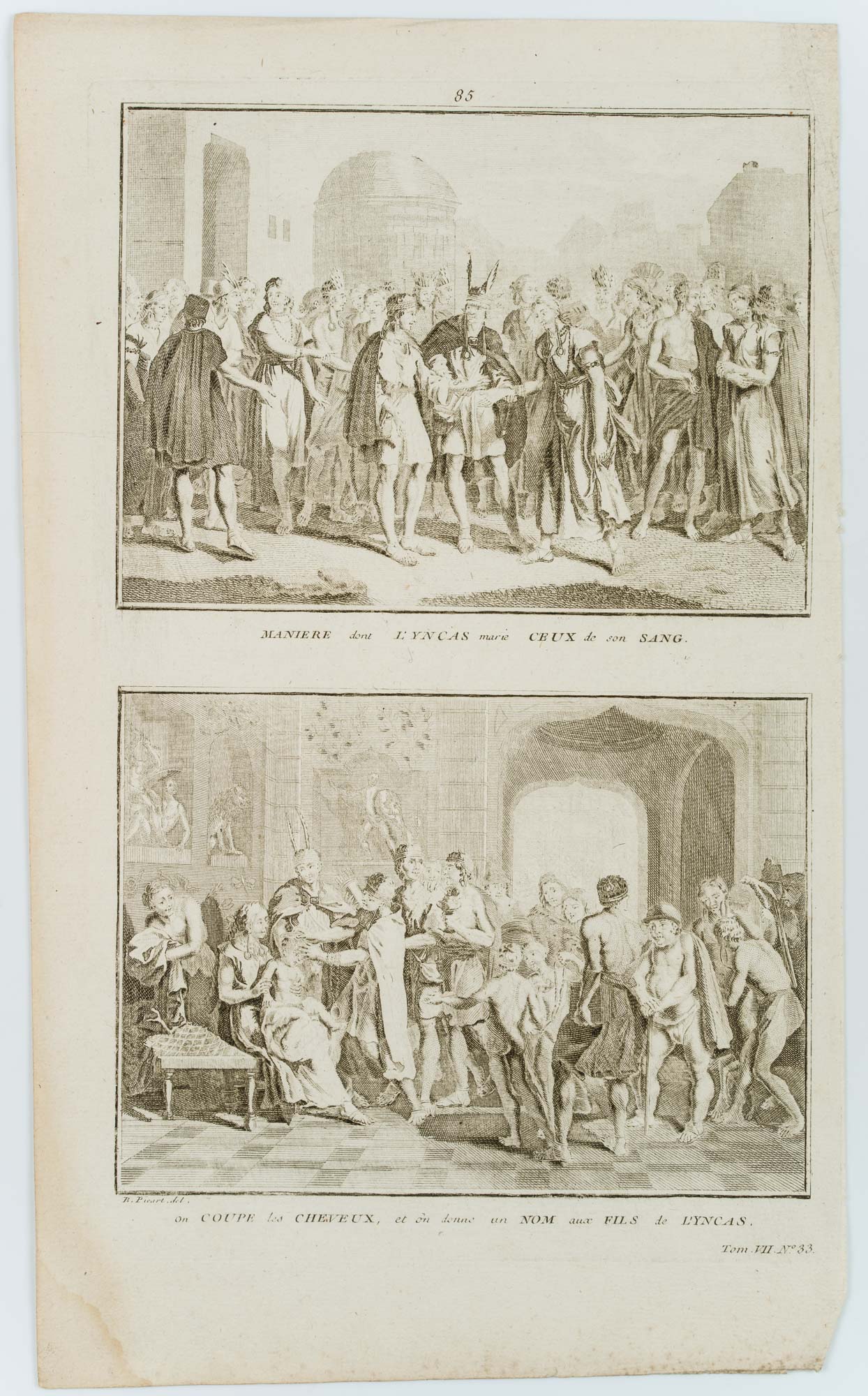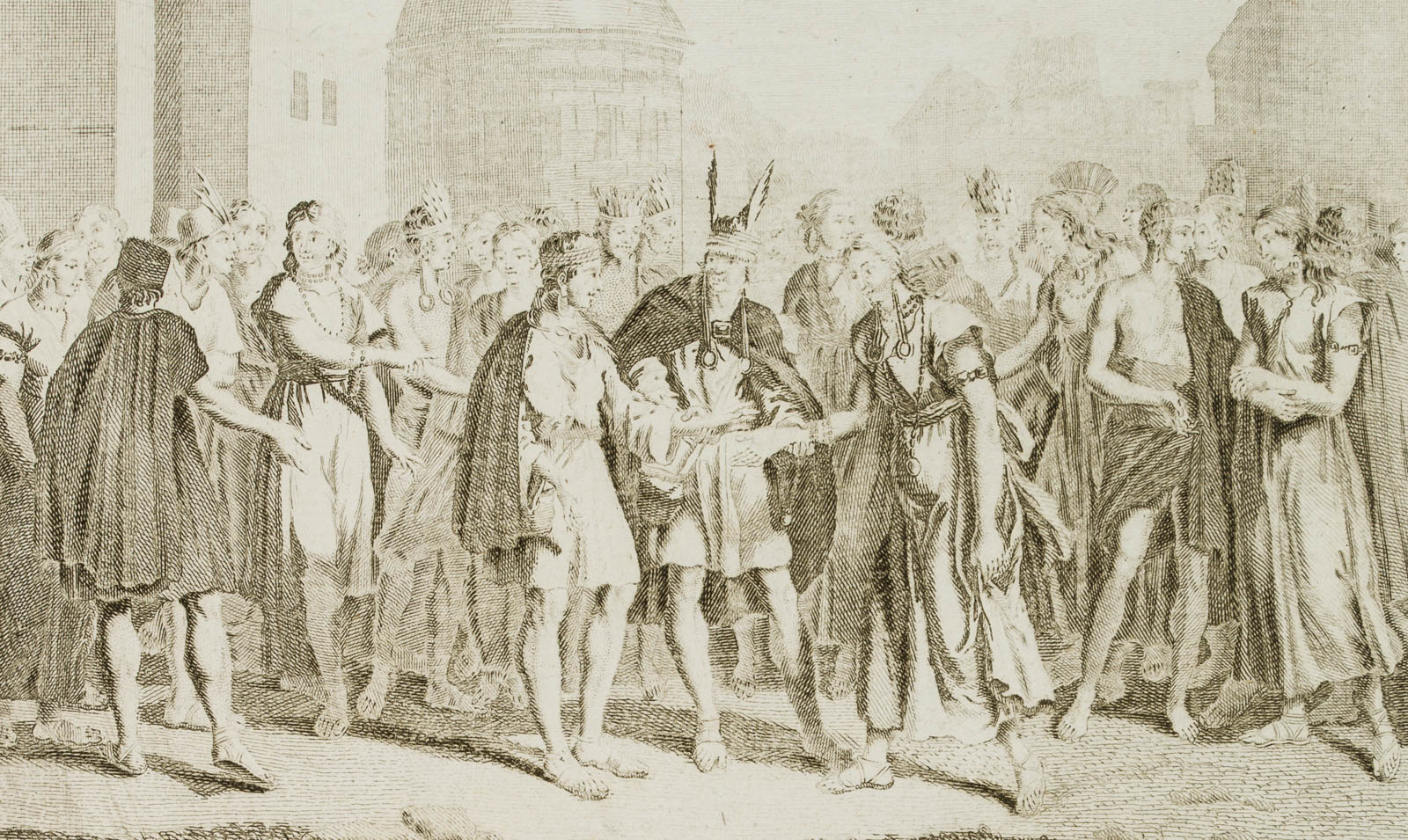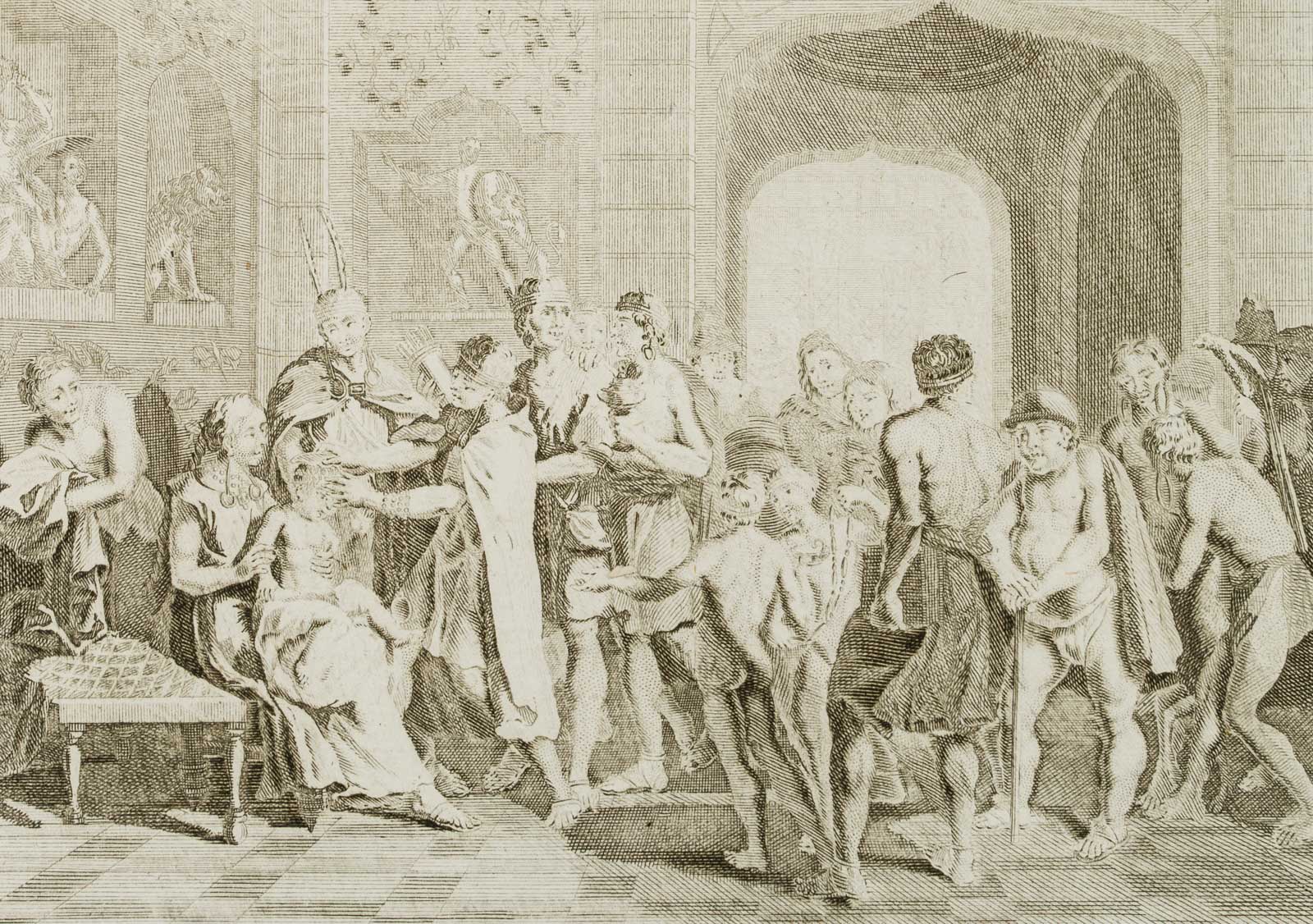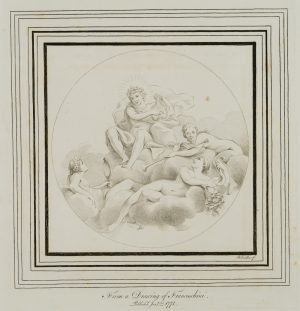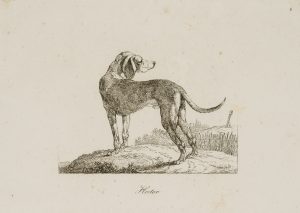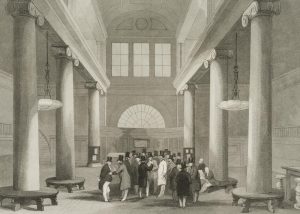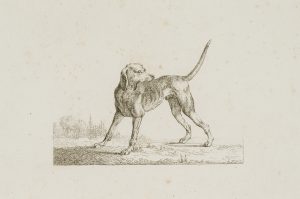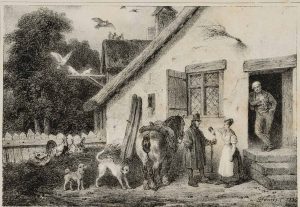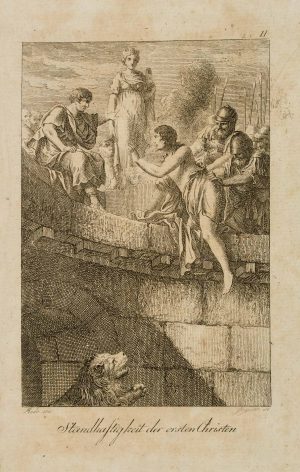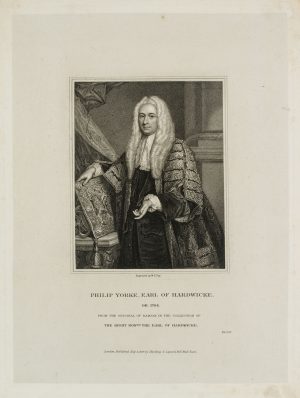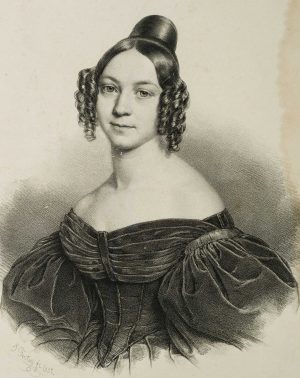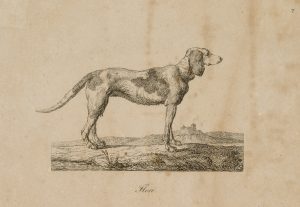Bernard Picart (1673 Parus – 1733 Amsterdam), Die Blutsheirat der Inkas, 1723, Kupferstich
- Technik: Kupferstich auf Büttenpapier
- Wasserzeichen: unbestimmte Zeichen – Nicht bestimmbares Wasserzeichen – Datierung:
- Bezeichnung: Links unterhalb der unteren Darstellung signiert “B. Picart del.”. Jeweils unterhalb der Darstellung betitelt “MANIERE dont L’yncas marié ceux de son SANG.”, “On COUPE les CHEVEUX, et on donne un NOM aux FILS de L’YNCAS.”. Über der oberen Abbildung nummeriert “85”, rechts unterhalb der unteren Abbildung bezeichnet “Tom. VII. No. 33.”
Mit Illustrationen von großer künstlerischer Qualität des französischen Kupferstechers und Buchillustrators Bernard Picart (1673 Paris – 1733 Amsterdam). Er studierte an der Académie Royale Zeichnen; 1696 ging er an die Akademie in Antwerpen und 1698 nach Amsterdam, wo er als Buchillustrator tätig war. 1702 heiratete er in Paris, wo er vor allem als Stecher tätig war. - Datierung: 1723
- Beschreibung: Seite aus dem 1723 erschienenen Buch des französischen Autors und Verlegers Jean Frédéric Bernard (1680 Velaux, Provence – 1744 Amsterdam): “Cérémonies et coûtumes religieuses de tous les peuples du monde représentés par des figures dessinées par Bernard Picart”. Die siebenbändige Folioausgabe über die Zeremonien und kultischen Ausdrucksformen sämtlicher bekannter Religionen war trotz des hohen Preises ein Bestseller der Epoche der Aufklärung. Vor allem durch die beim Publikum beliebten Illustrationen Bernard Picarts erlangte das Werk seine besondere Bedeutung. Dargestellt ist die Blutheirat der Inkas sowie die Zeremonie der Namensgebung eines Kindes, indem ihm die Haare geschnitten werden.
- Schlagworte: Trachten, Architektur, Frankreich, Barock, 1700-1749
- Größe: 40,0 cm x 23,5 cm, Darstellung: 14,8 cm x 20,4 cm
- Zustand: Akzeptabler Zustand. Das Blatt ist altersgemäß gebräunt und stockfleckig; in der unteren linken Blattecke ist ein Flüssigkeitsfleck festzustellen, horizontale Quetschfalte in der oberen Abbildung; die rechte obere Blattecke mit Knickspuren und mit Randeinriss, der verso geklebt wurde; entlang der Blattkanten stellenweise durch kleine Knicke und Einrisse beschädigt und lichtrandig. Die beiden Darstellungen machen einen hervorragenden Eindruck.
English Version:
Bernard Picart (1673 Parus – 1733 Amsterdam), The Inca Blood Marriage, 1723, Copper engraving
- Technique: Copper engraving on
- Watermark: – Undeterminable watermark – Date:
- Inscription: Signed on the left below the lower depiction “B. Picart del. Each titled below the image “MANIERE dont L’yncas marié ceux de son SANG.”, “On COUPE les CHEVEUX, et on donne un NOM aux FILS de L’YNCAS.”. Numbered “85” above the upper illustration, inscribed on the right below the lower illustration “Tom. VII. No. 33.”
With illustrations of great artistic quality by the French engraver and book illustrator Bernard Picart (1673 Paris – 1733 Amsterdam). He studied drawing at the Académie Royale; in 1696 he went to the Academy in Antwerp and in 1698 to Amsterdam, where he worked as a book illustrator. In 1702 he married in Paris, where he worked mainly as an engraver. - Date: 1723
- Description: Page from the book published in 1723 by the French author and publisher Jean Frédéric Bernard (1680 Velaux, Provence – 1744 Amsterdam): “Cérémonies et coûtumes religieuses de tous les peuples du monde représentés par des figures dessinées par Bernard Picart”. The seven-volume folio edition on the ceremonies and cultic expressions of all known religions was a bestseller of the Age of Enlightenment despite its high price. It was above all Bernard Picart’s illustrations, which were popular with the public, that gave the work its special significance. It depicts the blood marriage of the Incas and the ceremony of naming a child by cutting its hair.
- Keywords: 18th century, Baroque, Costumes, France,
- Size: 40,0 cm x 23,5 cm (15,7 x 9,3 in), Depiction: 14,8 cm x 20,4 cm (5,8 x 8 in)
- Condition: Rather good condition. The sheet is browned and foxed according to its age; there is a liquid stain in the lower left corner of the sheet, horizontal box pleat in the upper image; the upper right corner of the sheet with crease marks and with marginal tear, which was glued on verso; along the edges of the sheet damaged in places by small creases and tears and with light margins. The two illustrations make an excellent impression.

